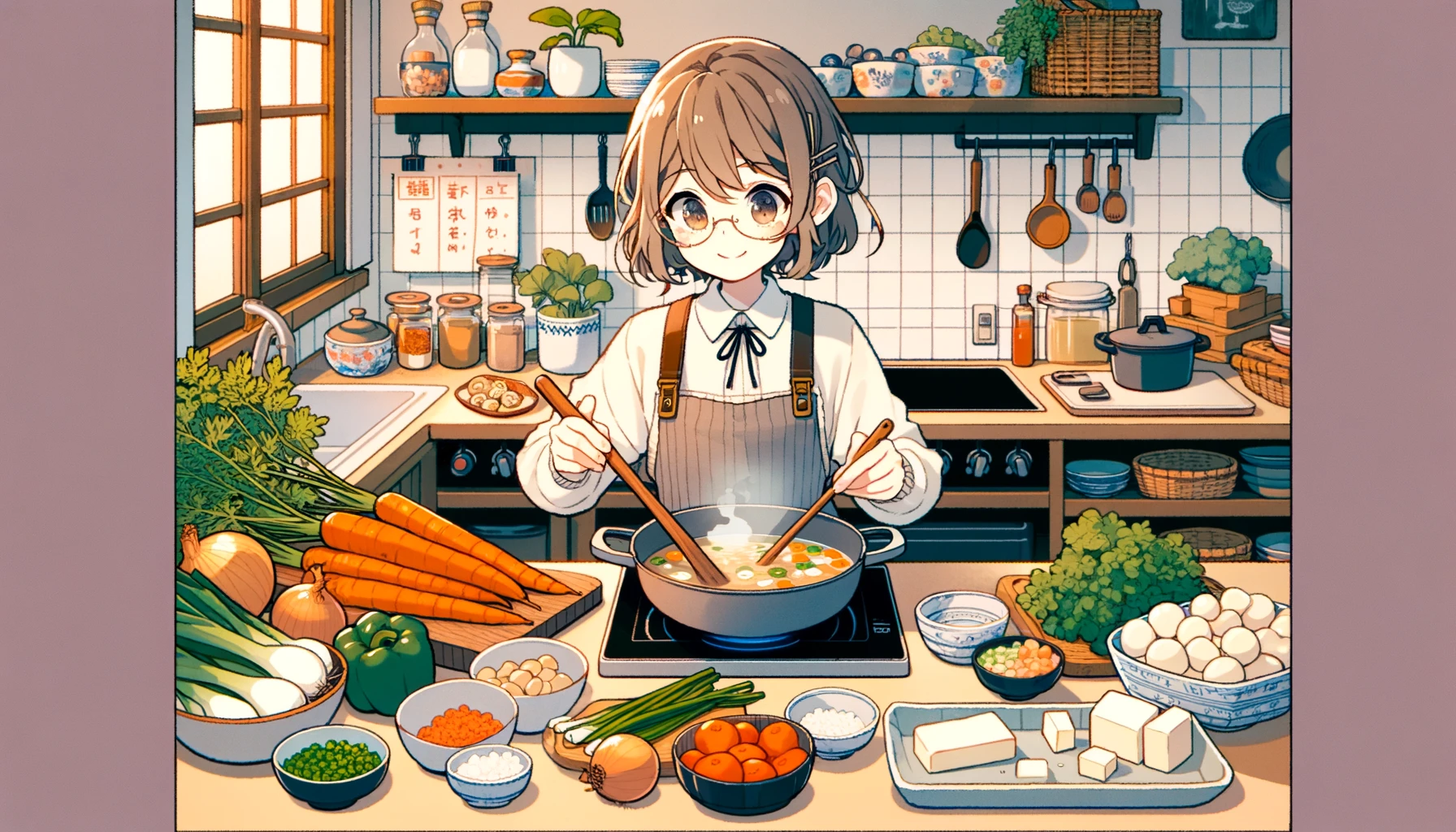- Published on
レッスン5_健康志向の手抜き生活_英語版
- Authors
- Name
- horomi
- Threads
- @herohoro_japan

The numbers on the sentence pattern list correspond to the numbers in the main text.
※ 参考文献:カルテット1(第五課 文型・表現ノート_p.142~148)
※ Reference: Quartet 1 (Lesson 5 Grammar & Expression Notes_p.142〜148)
文型リスト
( ):英訳
- 疑問詞 ~ても(no matter what/ who/ which/ when/ where/ how, etc)
- ~たびに(whenever ~; every time ~)
- ~はずだ(be supposed to ~; should ~)
- ~ておく(do something in advance)/ ~ないでおく(leave something undone)
- まず(first of all)/ 次に(next)/ それから(and then)/ 最後に(finally)
- もし~ても(even if ~)
- ~ように(so that ~)
- Nにする(decide on N)
- ~だけあって(as might be expected of ~)
本文
日本の食文化において、「一汁三菜」という考え方があります。
In Japanese food culture, there is a concept of "one soup, three dishes."
これは、一つの汁物と三つのおかずで構成される食事のスタイルのことです。This refers to a meal style composed of one soup and three side dishes.
バランスの良い食生活を送るための基本とされています。It is considered the basis for a balanced diet.
汁物には、味噌汁やスープなどがあり、主菜には肉や魚などのたんぱく質を中心とした料理を、副菜には野菜や海藻、豆腐などを使った料理を二品含めます。The soup includes miso soup and other soups, the main dish consists of protein-based dishes such as meat and fish, and the side dishes include two dishes made with vegetables, seaweed, tofu, etc.
一汁三菜の食事は、汁物、主菜、副菜2品という定められた組み合わせにすることで、栄養に関する専門的な知識がなくてもバランスの良い食事を作れます。The "one soup, three dishes" meal allows you to create a balanced meal without specialized knowledge in nutrition, by following the prescribed combination of soup, main dish, and two side dishes.
そこで今回は、「一汁三菜」の「汁物」に焦点を当てて、味噌汁の作り方を紹介します。So in this article, we will focus on the "soup" of "one soup, three dishes" and introduce how to make miso soup.
味噌汁には野菜をたくさん入れることにします。We will put a lot of vegetables in the miso soup.
野菜たっぷりの味噌汁だけあって、毎回の食事には欠かせません。The vegetable-rich miso soup is indispensable for every meal.
味噌は、発酵食品で、消化を助け、腸内環境を改善する効果があります。Miso is a fermented food that aids digestion and improves the intestinal environment.
このように、味噌と野菜の栄養を組み合わせることは、健康的な食事を手軽に取り入れるための簡単な方法です。In this way, combining the nutrition of miso and vegetables is an easy way to incorporate a healthy diet.
まず、冷蔵庫を開けてみます。First, open the refrigerator.
野菜を無駄にしないように、古いものから使います。Use the oldest vegetables first to avoid waste.
味噌汁に入れる野菜は、何を入れても美味しいです。Any vegetables can be delicious in miso soup.
主菜や副菜を作った時に残った野菜を使うのがおすすめです。It's recommended to use the vegetables left over from making main and side dishes.
次に、野菜を洗ってから包丁で切ります。Next, wash the vegetables and cut them with a knife.
味噌汁を作るたびに野菜を切るのが面倒に感じる場合には、主菜や副菜を作る時に味噌汁の具で使う大きさに切っておくとすぐに使えて便利です。If you find it bothersome to cut vegetables every time you make miso soup, it's convenient to cut them into the size you use for miso soup ingredients when you're making main dishes and side dishes.
準備ができたら、鍋に水を入れて火をつけます。Once you're ready, put water in a pot and turn on the heat.
根菜などの火の通りにくい野菜から先に入れて、中火で煮ます。Start with hard vegetables like root vegetables and simmer over medium heat.
沸騰したら、葉物などの火の通りやすい野菜を入れて、少し煮えたら弱火にします。Once it comes to a boil, add easily cooked vegetables like leafy greens, and once they're slightly cooked, turn the heat to low.
それから味噌を加えます。Then add the miso.
味噌は、直接入れず、おたまで味噌をすくって、少し鍋の汁を加えて箸で混ぜて味噌のかたまりを溶かします。Do not add the miso directly, but scoop it with a ladle, add a little soup from the pot, and mix it with chopsticks to dissolve the clumps of miso.
溶けた味噌の汁を鍋に加えていきます。Add the dissolved miso soup to the pot.
最後に全体をかき混ぜて味噌の汁が鍋全体に行き渡ったら完成です。Finally, stir the entire contents until the miso soup is evenly distributed, and it's ready.
もし食べきれなくても、鍋ごと冷蔵庫に入れておけばいつでも食べれます。If you can't eat it all, you can put the pot in the fridge and eat it anytime.
忙しい朝でも味噌汁だけは食べれるはずです。Even on busy mornings, you should be able to eat miso soup.
Podcast
この内容を音読して配信中です!
I am broadcasting this content aloud!
関連読み物
ここで扱った文型を使った読み物日記を他にも投稿します🗓
I also post other reading diaries using the sentence patterns discussed here🎉
別冊カルテットの単語リストを含めた読み物日記も作るよ〜💪
I have also made a reading diary including a word list of Separate Quartet 🚀